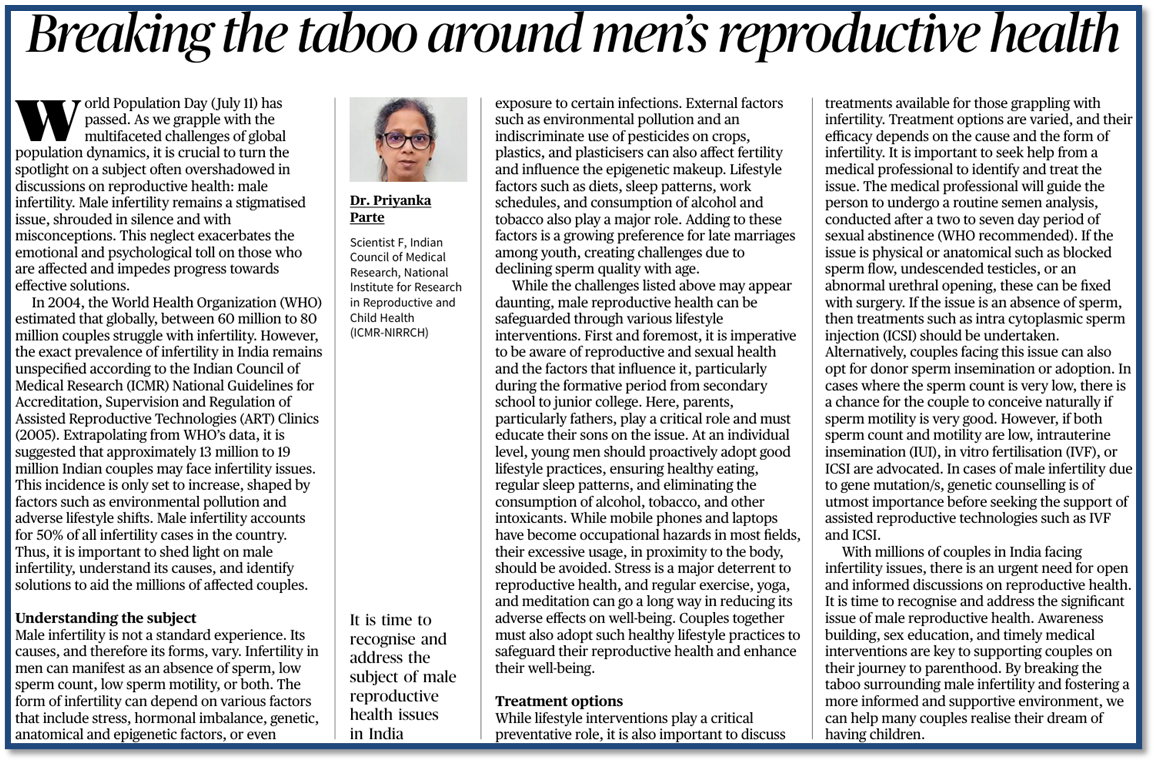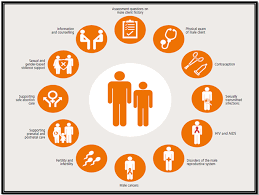The Hindu: Page 08
Syllabus: Indian Society: Population and associated issues

Context
- The article discusses the urgent need to address male infertility, a significant yet often overlooked aspect of reproductive health.
- Highlighting the prevalence, causes, and treatment options, it underscores the importance of awareness, lifestyle interventions, and open discussions to support affected couples and enhance their chances of parenthood.
Reproductive Health
- World Population Day (July 11) has passed. As we grapple with the multifaceted challenges of global population dynamics, it is crucial to turn the spotlight on a subject often overshadowed in discussions on reproductive health: male infertility.
- Male infertility remains a stigmatised issue, shrouded in silence and with misconceptions.
- This neglect exacerbates the emotional and psychological toll on those who are affected and impedes progress towards effective solutions.
- In 2004, the World Health Organization (WHO) estimated that globally, between 60 million to 80 million couples struggle with infertility.
- Extrapolating from WHO’s data, it is suggested that approximately 13 million to 19 million Indian couples may face infertility issues.
- This incidence is only set to increase, shaped by factors such as environmental pollution and adverse lifestyle shifts.
- Male infertility accounts for 50% of all infertility cases in the country. Thus, it is important to shed light on male infertility, understand its causes, and identify solutions to aid the millions of affected couples.
Understanding the subject
- Male infertility is not a standard experience. Its causes, and therefore its forms, vary. Infertility in men can manifest as an absence of sperm, low sperm count, low sperm motility, or both.
- The form of infertility can depend on various factors that include stress, hormonal imbalance, genetic, anatomical and epigenetic factors, or even exposure to certain infections.
- External factors such as environmental pollution and an indiscriminate use of pesticides on crops, plastics, and plasticisers can also affect fertility and influence the epigenetic makeup.
- Lifestyle factors such as diets, sleep patterns, work schedules, and consumption of alcohol and tobacco also play a major role.
- Adding to these factors is a growing preference for late marriages among youth, creating challenges due to declining sperm quality with age.
- While the challenges listed above may appear daunting, male reproductive health can be safeguarded through various lifestyle interventions.
- First and foremost, it is imperative to be aware of reproductive and sexual health and the factors that influence it, particularly during the formative period from secondary school to junior college.
- Here, parents, particularly fathers, play a critical role and must educate their sons on the issue.
- At an individual level, young men should proactively adopt good lifestyle practices, ensuring healthy eating, regular sleep patterns, and eliminating the consumption of alcohol, tobacco, and other intoxicants.
- While mobile phones and laptops have become occupational hazards in most fields, their excessive usage, in proximity to the body, should be avoided.
- Stress is a major deterrent to reproductive health, and regular exercise, yoga, and meditation can go a long way in reducing its adverse effects on well-being.
- Couples together must also adopt such healthy lifestyle practices to safeguard their reproductive health and enhance their well-being.
Treatment options
- While lifestyle interventions play a critical preventative role, it is also important to discuss treatments available for those grappling with infertility.
- Treatment options are varied, and their efficacy depends on the cause and the form of infertility.
- It is important to seek help from a medical professional to identify and treat the issue.
- The medical professional will guide the person to undergo a routine semen analysis, conducted after a two to seven day period of sexual abstinence (WHO recommended).
- If the issue is physical or anatomical such as blocked sperm flow, undescended testicles, or an abnormal urethral opening, these can be fixed with surgery.
- If the issue is an absence of sperm, then treatments such as intra cytoplasmic sperm injection (ICSI) should be undertaken.
- Alternatively, couples facing this issue can also opt for donor sperm insemination or adoption.
- In cases where the sperm count is very low, there is a chance for the couple to conceive naturally if sperm motility is very good.
- However, if both sperm count and motility are low, intrauterine insemination (IUI), in vitro fertilisation (IVF), or ICSI are advocated.
- In cases of male infertility due to gene mutation/s, genetic counselling is of utmost importance before seeking the support of assisted reproductive technologies such as IVF and ICSI.
Conclusion
- Open and informed discussions on reproductive health are urgently needed, particularly for male infertility.
- Awareness building, sex education, and timely medical interventions can support couples on their journey to parenthood.
- Breaking the taboo surrounding male infertility and fostering a supportive environment can help many couples achieve their dream of having children.
Evolution of Family Planning Programmes in India
- Early Beginnings and Clinic-Based Approaches
• India was one of the first countries to launch a national family planning programme in 1952.
• Initially, the programme was predominantly clinic-based, focusing on providing contraceptive services through established healthcare facilities
• This phase marked the beginning of government-led efforts to address population growth and promote family planning to improve public health and economic stability.
- Shift Towards Target-Oriented Methods
• In the subsequent decades, the programme shifted towards more aggressive, target-oriented methods.
• The government set specific numerical targets for contraceptive acceptance and sterilizations, aiming to rapidly reduce birth rates.
• While this approach succeeded in increasing the adoption of family planning methods, it also faced criticism for its coercive tactics and lack of emphasis on voluntary participation and informed choice.
- Voluntary Adoption and Rights-Based Approach
• Responding to the criticisms of the target-oriented phase, India’s family planning programme began to emphasise voluntary adoption of contraceptive methods.
• The shift towards a rights-based approach focused on respecting individuals’ reproductive rights and providing a broader range of contraceptive options.
• This transition underscored the importance of informed choice and aimed to empower women and couples to make decisions about their reproductive health.
- Integration with Health Initiatives
• In 2012, the Reproductive, Maternal, Newborn, Child, and Adolescent Health (RMNCH+A) approach was introduced, integrating family planning with other health initiatives.
• This holistic approach recognised that family planning is intricately linked with broader health outcomes.
• By combining efforts to improve maternal and child health with family planning services, the programme aimed to create synergies that would enhance overall health outcomes and reduce maternal and child morbidity and mortality.
- Family Planning (FP) Campaigns in 2020 and 2030
• India’s commitment to global family planning initiatives was further solidified with its participation in the FP2020 and subsequent FP2030 campaigns.
• These initiatives focused on expanding access to family planning information and services, particularly for marginalized and underserved populations.
• They aimed to ensure that more women and girls could exercise their reproductive rights and have access to a full range of contraceptive methods.
- Expanding Contraceptive Choices and Quality Assurance
• The evolution of India’s family planning programme has also seen an expansion in the range of contraceptive choices available to the population.
• Modern reversible contraceptives, such as condoms, intrauterine contraceptive devices (IUCDs), oral pills, and injectable contraceptives, are now widely available.
• Pilot programmes are also introducing subdermal implants and subcutaneous injections to further broaden the options.
• Ensuring the quality of these services has become a priority, with efforts to provide comprehensive training to healthcare providers and implement robust quality assurance mechanisms.
Family Planning Impact on Growth and Development
- The growth and development of a country are linked to population dynamics.
- The aim is to maintain and achieve replacement levels of fertility both nationally and sub-nationally.
- India has already achieved a replacement level of fertility at the national level (TFR 2.0), and 31 states/UTs have already achieved this milestone as per NFHS-5 (2019-21).
- Family planning has also been recognised globally as reducing maternal and child morbidity and mortality.
Mission Parivar Vikas, Its Expansion and Innovation in Family Planning Services
- Mission Parivar Vikas (MPV)
• This is one of the flagship family planning programmes of the government, was launched in 2016.
• The aim is to increase access to contraceptives and family planning services in 146 high fertility districts across seven states (Bihar, MP, Rajasthan, UP, Chhattisgarh, Jharkhand, and Assam).
• The approach uses awareness campaigns such as Saarthi Vaahans (awareness on wheels) and Saas Bahu Sammelens to address social barriers for young women accessing contraceptives, and providing Nayi Pahel kits to newly married couples to sensitise them about responsible parenthood practices.
- Expansion and Innovation in Family Planning Services
• Improvements in the uptake of modern contraceptives in the MPV districts led to the government’s decision to scale up this programme to all districts of the seven states and in six Northeastern states in 2021.
• Currently, the National Planning programme offers a variety of reversible modern contraceptives, including condoms, intrauterine contraceptive devices, oral pills, MPA injections, and more.
• In 10 states, covering two districts each, subdermal implants and subcutaneous injections are in the rollout stage, with plans for further extension.
Way Forward: Need to Reaffirm Commitment to Overcoming Barriers
- As India commemorates World Population Day 2024, themed “Healthy Timing and Spacing of Pregnancy for the Health and Well-being of Mother and Child,” India acknowledges the efforts of state counterparts and the relentless dedication of our health workforce.
- This includes ANMs, ASHAs, and other ground-level functionaries who are at the forefront of delivering crucial services.
- The government should reaffirm its commitment to overcoming barriers related to access, misconceptions about contraceptive methods, lack of awareness, geographical and economic challenges, and restrictive social and cultural norms.
- Substantial investments are being made to improve family planning service delivery, including ensuring the availability of both temporary and long-term contraceptive methods.
- Additionally, family planning services are being extended to the last mile through Ayushman Arogya Mandirs.








